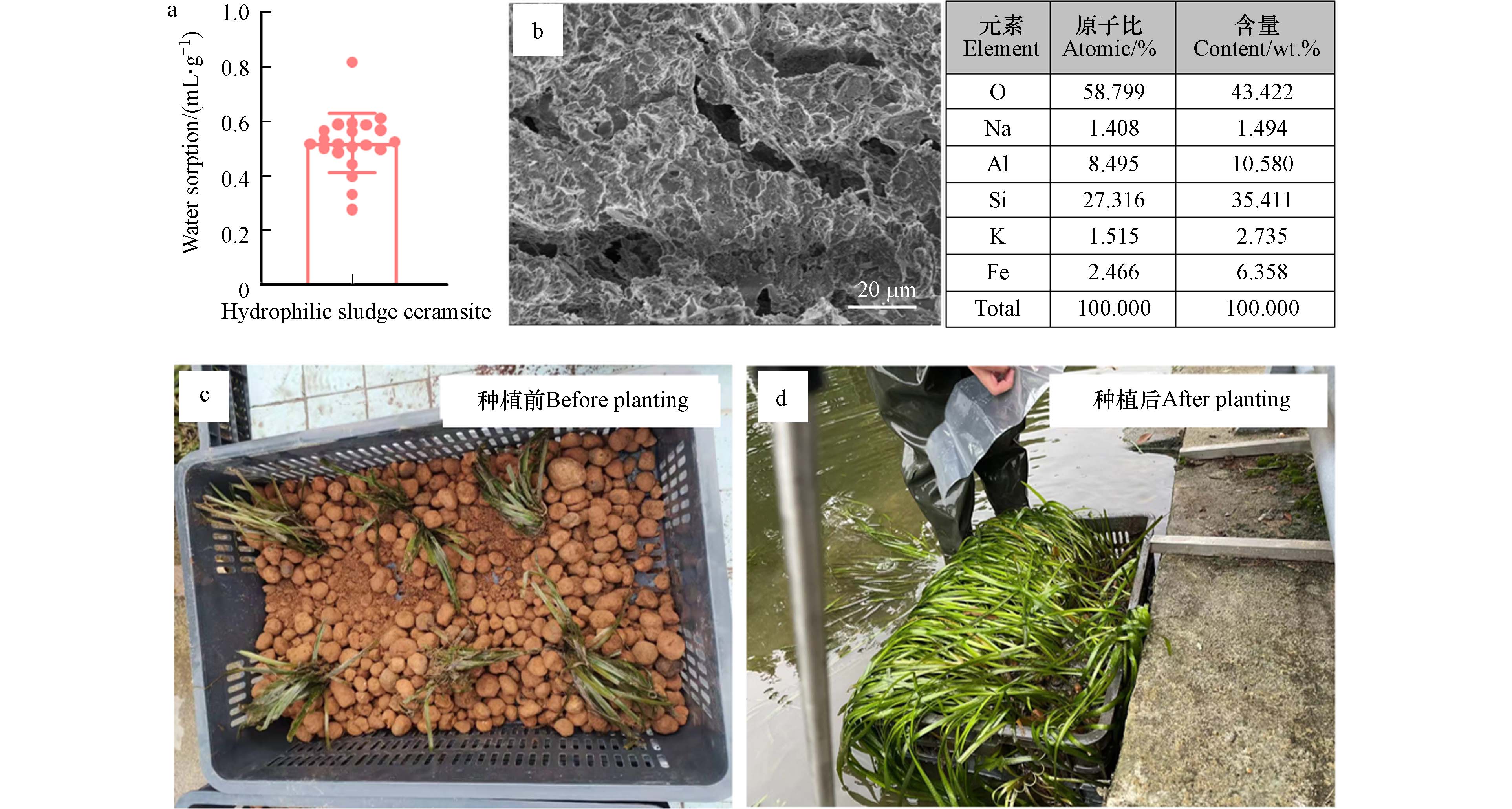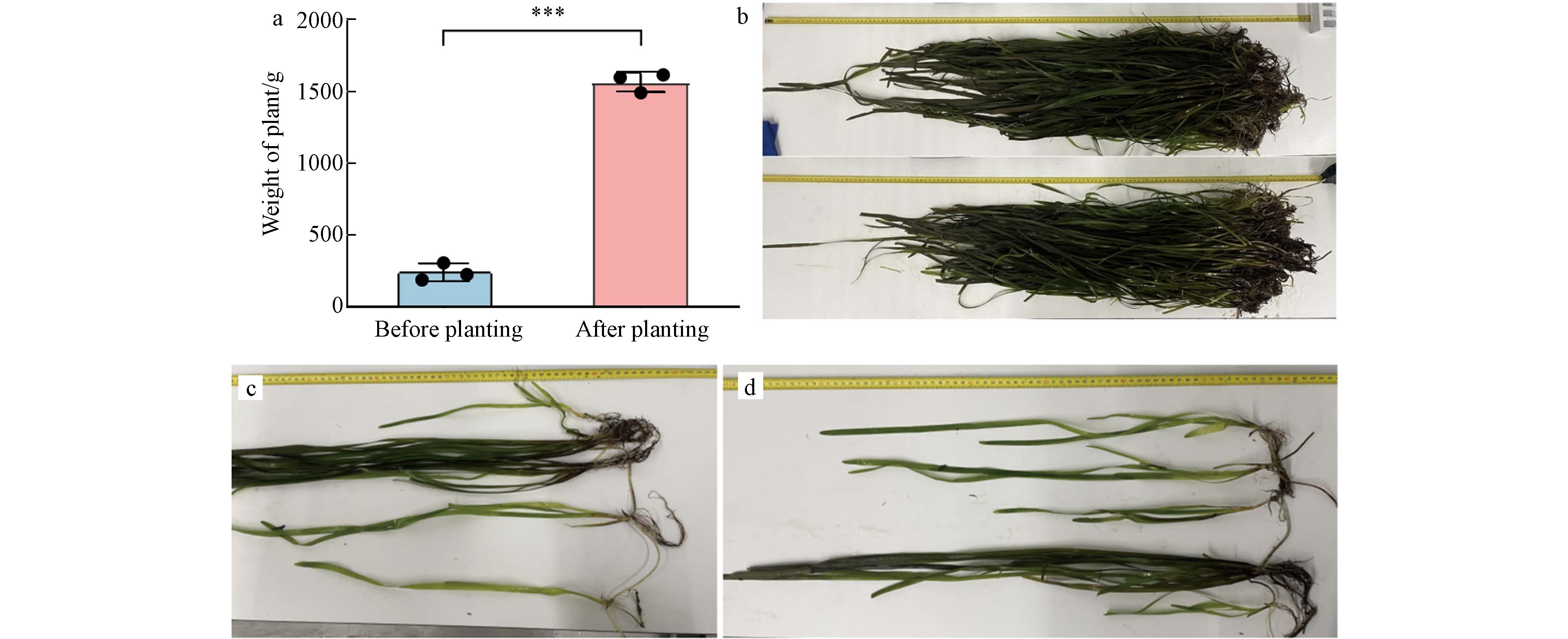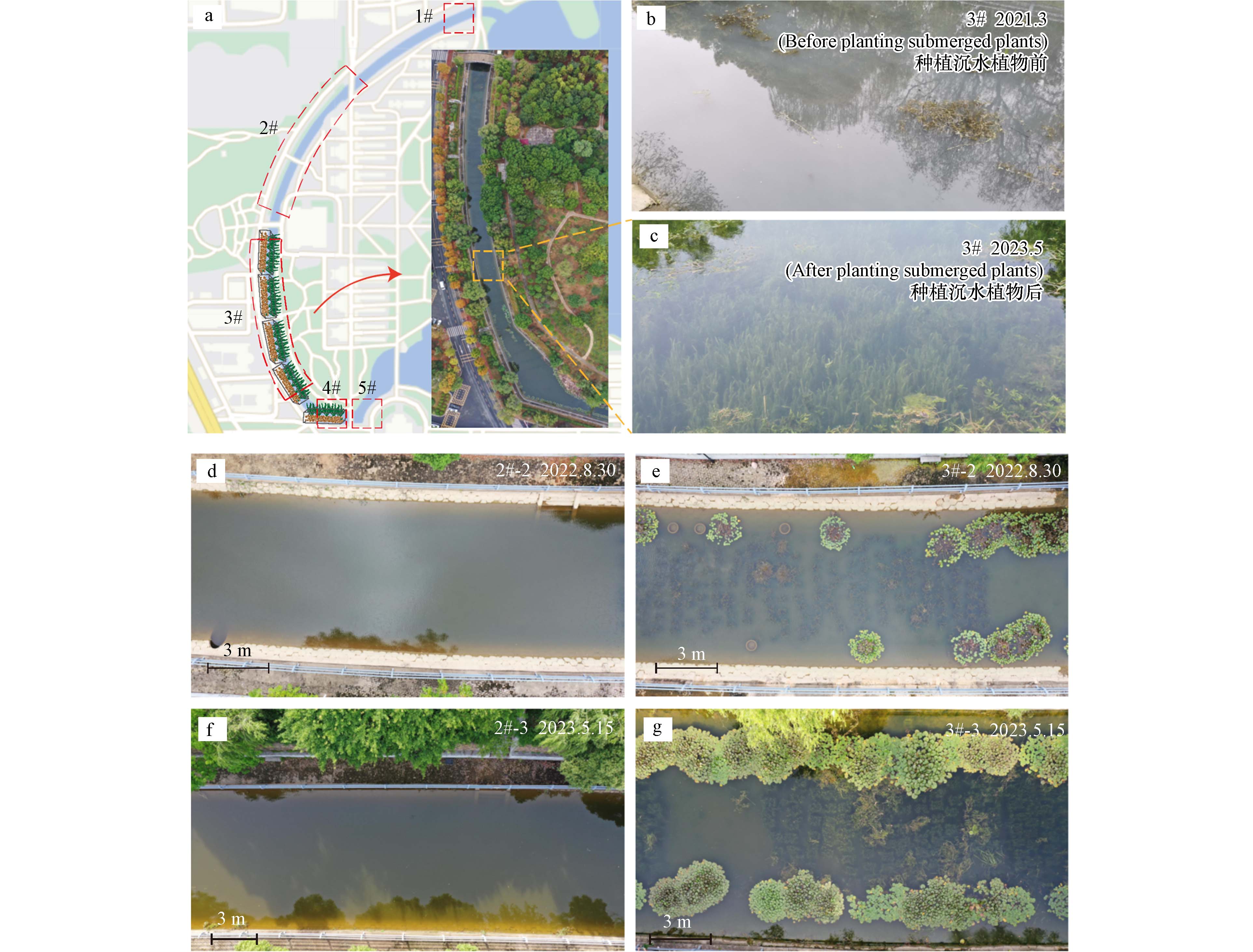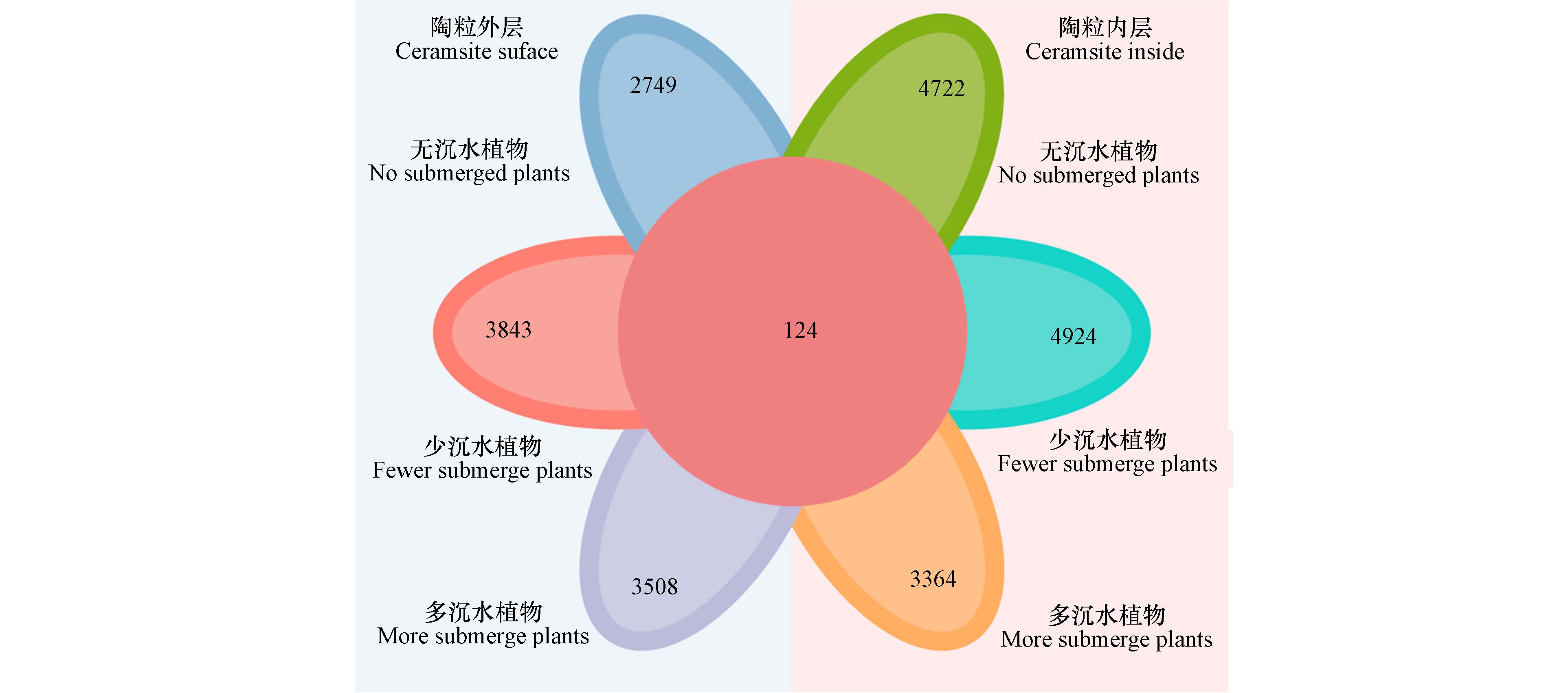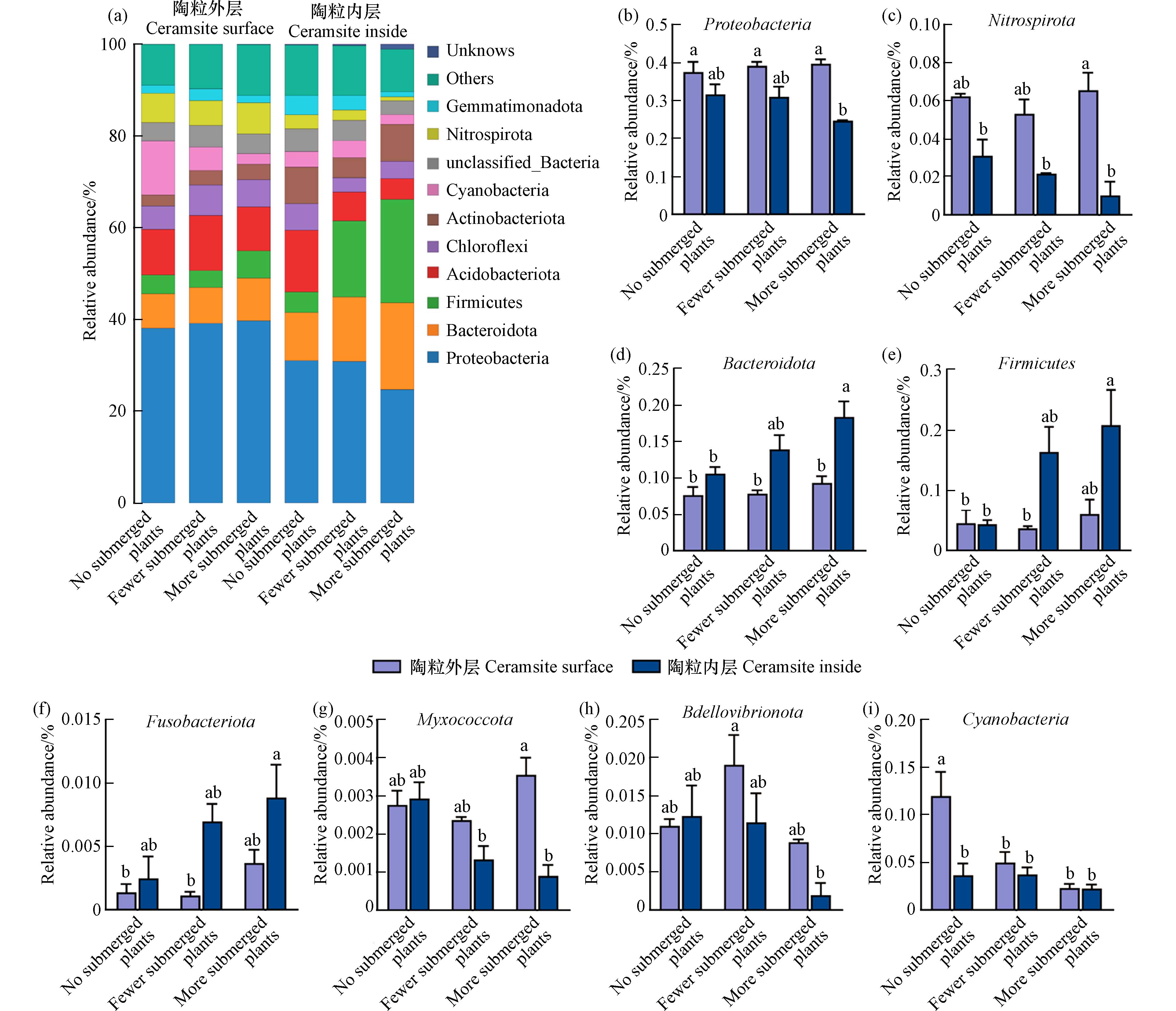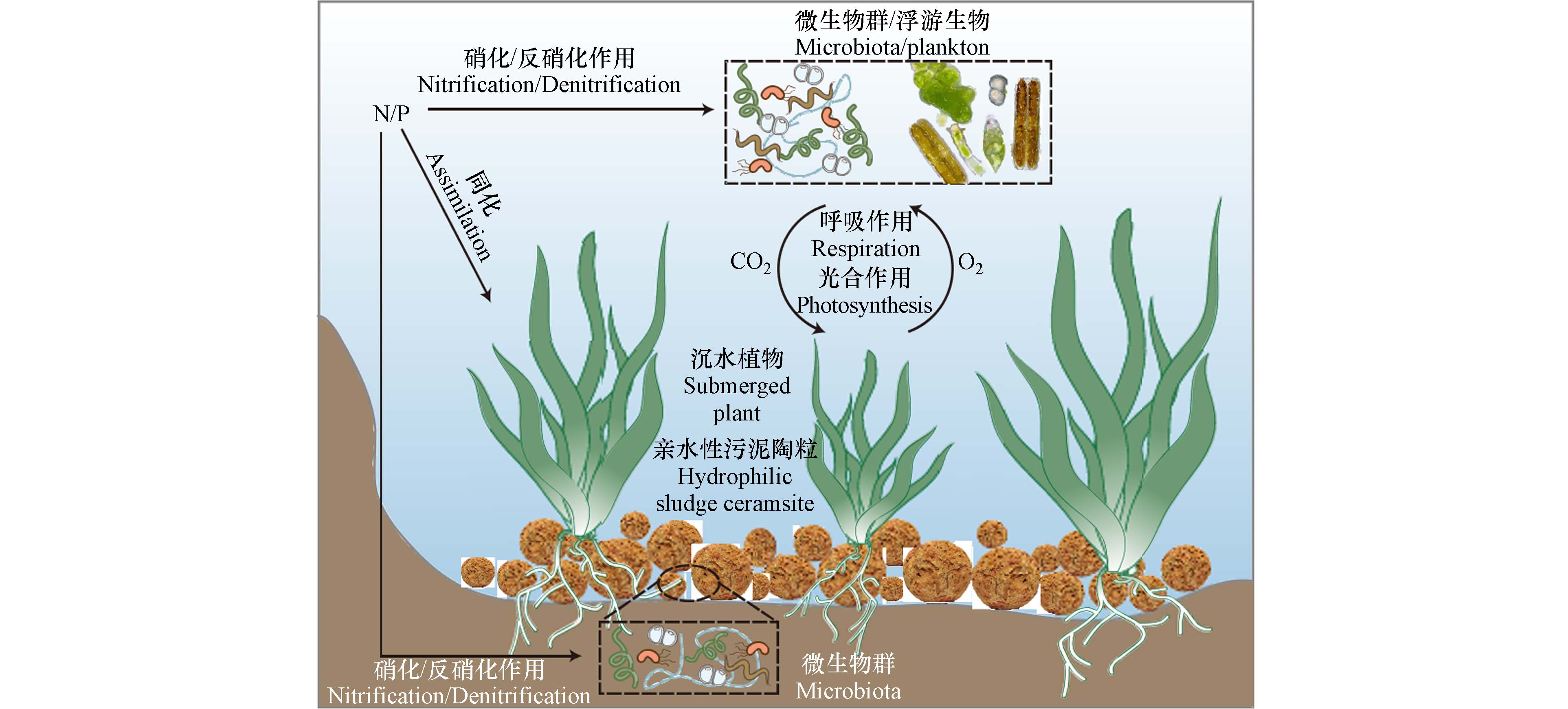-
黑臭水体是城市化进程中水生系统面临的一个重要的环境问题. 2015年国务院发布的《水污染防治行动计划》(简称“水十条”)中明确要求,采取控源截污、垃圾清理、清淤疏浚、生态修复等措施,加大黑臭水体治理力度[1]. 其中生态修复主要利用微生物、水生动植物等生物的生命活动,对水中污染物进行转移、转化及降解,恢复水体在一定污染负荷下的自净化能力[2]. 在水生态修复工作中,恢复水生植物尤其是恢复沉水植物被广泛认为是水体治理的有效途径[3]. 目前用于恢复河湖生态的沉水植物种植常通过排干上覆水、清淤后将沉水植物种植于水体土壤中,再蓄水使沉水植物生长达到净化水质、防治污染的目的. 但该种植方式耗时长、成本高,且河湖清淤后的底质较硬,植物生长必需的营养物质也随清淤过程被移除,导致沉水植物成活率较低. 另外,部分城市硬化沟渠因其“三面光”的特点,在发生黑臭后的生态修复主要依靠生态浮岛种植浮水植物,而沉水植物需要沉没于水中完成生活史,其通过光合作用产生的氧气都释放到水中,可以显著增加水体中的溶解氧含量[4]. 因此,开发新型种植技术提高沉水植物的河湖生态修复效果具有重要意义.
针对沉水植物种植困难的问题,目前有基于砾石和滤料构成的生物循环床[5]、网床或网箱[6],以及基于苯乙烯和树脂构成的生态浮岛[7]. 而这些基质都存在经济和环境效益问题,例如维护成本高、微塑料释放等. 污泥陶粒是污泥稳定化、轻量化及无害化处置的产物,具有比表面积大和多孔结构等特性. 据统计,至2021年全国已建成
2827 座城市污水处理厂,每年产生的污泥量约3000 —6000 万t[8]. 我国污水处理产业因处理能力、技术和投入仍存在不足,行业内“重水轻泥”的现状依然没有得到有效改善,导致大量污泥未能得到有效处置[9]. 目前研究报道的污泥陶粒基于其多孔结构的特性已被广泛用作建筑材料[10]、人工湿地基质[11 − 13]、滤池填料[14 − 16]和各种水处理设备的滤材[17]. 已报道的污泥陶粒中,吸水率大多在50% 以下,导致其应用于人工湿地时需补充土壤或砂砾才能满足湿地植物的种植[12]. 而亲水性污泥陶粒保水保墒更利于植物的定植和生根,在提供固着基质的同时,还能避免植物烧根[17]. 同时亲水性污泥陶粒的吸附性能使得其可为植物根系提供营养物质,更利于植物的生长发育. 通过污泥陶粒构建的人工湿地用于污水处理后,能值产出和可持续性指数相较其他污泥处置方式更高[11]. 因此,开发利用亲水性污泥陶粒种植水生植物不仅能解决沉水植物种植困难的问题,还能进一步实现污泥资源化利用,具有可观的经济效益,符合可持续性发展的需求.基于此,本研究提出亲水性污泥陶粒可作为水生植物的栽培基质(“新型土壤”),提高水生植物存活率. 开发一套运用亲水性污泥陶粒种植沉水植物构建“水下森林”生态系统的新策略,以恢复淡水生态系统的结构和功能并改善水质. 该策略的实施将为城市淡水生态系统实现固碳增汇,为“双碳”目标的实现提供新思路.
-
亲水性污泥陶粒购自武汉铭创新海生态科技有限公司,公司基于专利“一种高掺量污泥蓄水材料的制备工艺,CN
114920541 A”进行制备,具体制备流程为将污泥、秸秆和添加剂按比例混合均匀后经过造粒及造粒后在窑炉中1000 ℃烧结20 min制备而成. 亲水性污泥陶粒的形貌结构用Hitachi SU8000扫描电子显微镜(SEM)和能谱仪(EDS)进行表征. 吸水率由公式(1)得出:其中V0为溶液初始体积,V为亲水性污泥陶粒吸水后溶液的体积,m为亲水性污泥陶粒的质量.
-
“水下森林”的构建由灰色聚丙烯材质的网篮作为固定单元,装入一定质量的亲水性污泥陶粒,并将苦草(Vallisneria natans (Lour.) H. Hara)埋入亲水性污泥陶粒中5 cm,将种植模块整体沉入水中.
每个种植模块种植固定质量的沉水植物,选取3个种植模块进行标记并记录沉水植物的具体质量和叶长. 经过生长两年后,取出标记模块,收集模块中所有沉水植物后,返回实验室对收集到的沉水植物进行清洗,去除根系附着的土壤等,自然沥干1 h后进行称重和叶长记录.
-
江汉大学校河—清源河呈“C”型,两端分别联通于三角湖,有闸口可控制三角湖水的输入与排放,全长约1 km,水深约1—1.3 m,河道经水泥硬化处理. 作为校园雨水和生活污水的汇集地,清源河存在许多外源氮、磷输入,并且由于清源河的水泥硬化人工河道,导致水体自净能力不足,进而水质逐渐恶化. 自2021年7月分别于3#和4#号点位种植了苦草构建淡水生态系统,并设置5个取样点(1#、2#、3#、4#、5#)监测水质变化. 取样点分布如图1所示.
为探究种植沉水植物后微生物群落的变化,分别在无草水域、少草水域和多草水域采亲水性污泥陶粒样本,取亲水性污泥陶粒内(距中心点0.5 cm半径以内材料)外(距中心点0.5 cm半径以外的材料)样本. 每个样本准备3个重复样品,共18个样品进行16S rRNA测序分析.
-
本研究测定了清源河5个监测点的 6项水质指标. 其中,溶解氧(DO)采用化学探头法(HJ 506-2016)(便携式多参数水质分析仪,YSIproQuatro)测定;高锰酸盐指数(CODMn)采用酸性法(GB/T
11892 -1989)(连续数字滴定仪,Titrette)测定;氨氮(NH4+-N)采用纳氏试剂分光光度法(HJ 535-2009)(紫外可见分光光度计,UV-7504 )测定;硝酸盐氮(NO3−-N)采用离子色谱法(HJ 84-2016)(离子色谱,AQ-1100 )测定;总氮(TN)采用碱性过硫酸钾消解紫外分光光度法(HJ 636-2012)(紫外可见分光光度计,UV-1800PC);总磷(TP)采用钼酸铵分光光度法(GB/T11893 -1989)(紫外可见分光光度计,UV-7504 )测定. -
使用TGuide S96 Magnetic Soil /Stool DNA Kit (天根生化科技(北京)有限公司),按照说明书,从18个样品中提取全基因组DNA. 用引物338F: 5’- ACTCCTACGGGAGGCAGCA-3’和806R: 5’- GGACTACHVGGGTWTCTAAT-3’扩增细菌16S rRNA高变区V3—V4. PCR产物在琼脂糖凝胶上检测,并通过Omega DNA纯化试剂盒(Omega Inc., Norcross, GA, USA)纯化. 收集纯化的PCR产物,在Illumina Novaseq
6000 平台上进行2 × 250 bp的配对. 使用USEARCH将相似阈值大于97%的符合条件的序列分配到一个操作分类单元(OTU). 数据结果上传到国家生物信息中心https://ngdc.cncb.ac.cn/bioproject/,项目编号PRJCA021118,GSA编号CRA014420. 基于QIIME2中的朴素贝斯分类器,使用SILVA数据库对OTUs/ASV进行分类标注,置信阈值为70%. 利用QIIME2软件对各样本物种多样性复杂性进行Alpha鉴定. 采用主坐标分析方法计算Beta多样性,评价样品的物种复杂性. 采用单因素方差分析比较细菌丰度和多样性. -
高温烧制的亲水性污泥陶粒具备了吸水性、多孔结构、比表面积大等特性. 其中,亲水性污泥陶粒的球体结构组成的间隙利于沉水植物的生根和固着,能有效提高沉水植物在恶劣环境的存活率,同时避免传统种植方式中营养元素过剩导致的植物烧根现象[17]. 本研究采用的亲水性污泥陶粒的吸水率可达0.522 mL·g−1(图2 a),这为微生物定殖和物质交换提供了良好的基础. 亲水性污泥陶粒的扫描电镜图像显示其具有丰富的孔径,且元素组成与土壤极为相似,主要含有氧、硅、铝等元素(图2 b). 因此,亲水性污泥陶粒的亲水性和多孔结构可以实现吸附营养物质、过滤悬浮物、为微生物和小型浮游动物提供栖息地,固着沉水植物根系并提供营养物质等功能. 本研究以网篮作为固定单元,亲水性污泥陶粒作为种植基质种植沉水植物,种植方式见图2 c. 经过两年时间的生长,沉水植物不仅存活率高,且长势良好(图2 d). 虽然高温烧制去除了污泥中原有的大部分氮、磷、有机质等植物生长必需物质,但其特有的亲水性和多孔结构使亲水性污泥陶粒可以从水体中有效吸附氮、磷、有机质、微量元素等维持水生植物的正常生长[17]. 水生植物的光合作用可以为微生物和浮游生物提供氧气,微生物和浮游生物呼吸作用产生的二氧化碳和代谢产生的有机物可以被水生植物吸收利用,实现正向的生态循环[18].
-
本文将亲水性污泥陶粒作为水生植物的栽培基质(“新型土壤”),用于种植水生植物,恢复淡水生态系统的结构和功能. 不同于传统的将沉水植物直接种植在河湖底泥的方式,利用陶粒作为“新型土壤”种植沉水植物仅需在固定装置中装满陶粒,将沉水植物根部栽种至陶粒间隙后即可通过不同的方式将种植模块放置于河湖渠底部,实现沉水植物的高效种植(图2 c). 本研究中,苦草种植前后的分蘖数及生物量显著增多. 每框植物的平均重量从种植前的241.20 g显著增长至
1566.13 g (图3 a),植物叶长从40 cm增长至120 cm (图3 b). 且经过两年的定植,植物能分蘖出2—3株新植株,新分蘖的植株最长能到60 cm (图3 c和d). 上述结果表明亲水性污泥陶粒种植模块利于沉水植物的定植. 亲水性污泥陶粒种植沉水植物的方法相较于传统种植更高效、经济. 这种方式无需排干河湖,简化了种植过程,节省了时间和成本. 其模块化设计使得维护更为便捷,仅需替换长势不良的模块,而无需大规模更换植物或排干水体. -
自2021年7月于3#和4#点位用亲水性污泥陶粒种植模块种植了苦草,并设置1#、2#和5#点位作为对照(图4 a),以此探究该种植方式构建新淡水生态系统的潜力. 至2023年5月沉水植物生长状态良好(图4 b). 自2022年2月起对3#号种植点和2#号对照点进行了生态系统拍摄(图4 d-g). 由图4 b和c可看出,相较于种植沉水植物之前,亲水性污泥陶粒种植的沉水植物生长正常,水体透明度高,并基本构建了清源河“水下森林”新淡水生态系统. 从2022年2月至2023年12月的一年多时间里,种植区的沉水植物生长正常,水体透明度及水质状况呈现持续向好的趋势,生态系统保持较好(图4 e,g,3#号点),未种植沉水植物的水域始终浑浊(图4 d,f,2#号点).
为评估亲水性污泥陶粒种植沉水植物构建“水下森林”新淡水生态系统用于改善水质的实际效果,分别于秋季(2022年11月)、冬季(2023年2月)和春季(2023年5月)测定了种植点和对照点水质相关参数. 溶解氧(DO)、总磷(TP)、总氮(TN)、氨氮(NH4+-N)和硝酸盐氮(NO3−-N)的结果表明,沉水植物种植点位(3#和4#点)的DO含量为明显高于对照点,且呈现了随种植时间递增的趋势,至2023年春季水体DO含量可达11.47 mg·L−1,有益于水生生物的生存及污染物的降解;而TP、TN、NH4+-N、NO3−-N浓度低于其它点位,且呈现了明显的下降趋势(表1). 污染物浓度上,基于国家地表水环境质量标准(GB
3838 -2002)[19],运用亲水性污泥陶粒种植了沉水植物的点位(3#和4#点)较对照点相比,总体水质已从劣V类提升至近III类(表1). 其中,水体TN从劣V类(2022年11月2#点,> 8.0 mg·L−1)水质恢复至近III类(2023年5月4#点,< 1.0 mg·L−1);NH4+-N从IV类(2022年11月2#点,> 5.0 mg·L−1)水质恢复至近I类(2023年5月3#和4#点,< 0.15 mg·L−1);TP从劣V类(2022年11月1#点,> 0.5 mg·L−1)水质恢复至III类/近II类(2023年5月3#和4#点,< 0.05 mg·L−1);高锰酸钾指数(CODMn)提升至II类(2023年5月4#点,< 2.5 mg·L−1)水质;DO提升至I类水质(2023年5月3#和4#点,> 11 mg·L−1)(表1). 以上结果表明,亲水性污泥陶粒种植沉水植物构建“水下森林”新淡水生态系统能有效改善河湖水质,实现了污泥资源化产物的再利用和黑臭水体的生态修复. -
沉水植物可调节水体中溶解氧的动态改变,水体中溶解氧的升高则是影响生态重构和生物多样性的关键因素[20]. 考虑到黑臭水体的形成与厌氧菌大量繁殖直接相关[21],本文分析了亲水性污泥陶粒内外定殖的微生物群落结构及生物多样性. 分别在无草水域、少草水域和多草水域采污泥陶粒样本,经过16S rRNA测序得到
26731 个分类单元(operational taxonomic units,OTU). 其中,无草水域的污泥陶粒外层有2749 个OTU,少于其内层(4722 个OTU). 少草水域的污泥陶粒外层有3843 个OTU,少于其内层(4924 个OTU). 多草水域的污泥陶粒外层有3508 个OTU,略多于其内层(3364 个OTU)(图5). 结果表明无论是否存在沉水植物,污泥陶粒内层定殖的微生物种类均多于外层,这表明亲水性污泥陶粒的球体结构适合微生物的栖息和繁殖. 在物种分布柱状图中,研究结果得到了污泥陶粒的优势细菌门,分别为变形菌门(Proteobacteria),拟杆菌门(Bacteroidota),厚壁菌门(Firmicutes),酸杆菌门(Acidobacteriota),绿弯菌门(Chloroflexi),放线菌门(Actinobacteriota),蓝藻门(Cyanobacteria),螺旋硝化菌门(Nitrospirota)和芽单胞菌门(Gemmatimonadota)(图6 a). 其中,好氧菌属的变形菌门(Proteobacteria)和硝化螺旋菌门(Nitrospirota)在污泥陶粒外部相对丰度较高,且在多草水域的污泥陶粒内外差异显著(图6 b和c). 专性厌氧的拟杆菌门(Bacteroidota)、梭杆菌门(Fusobacteriota)和多为厌氧菌的厚壁菌门(Firmicutes)在污泥陶粒内部的相对丰度较多,且随着沉水植物的增多,污泥陶粒内外差异逐渐显著(图6 d,e和f). 捕食性微生物作为微生物群落中的捕食者,在维持微生物群落的多样性及生态功能中发挥重要作用[22-23]. 由图6 g、h可知,在沉水植物种植水域的污泥陶粒中,黏细菌(Myxococcota)和蛭弧菌(Bdellovibrionota)等捕食性微生物更倾向于分布在污泥陶粒的表层,水体中溶解氧的升高可直接影响污泥陶粒表层和内部微生物群落结构的组成和功能. 但沉水植物过多后,无论是污泥陶粒外层还是内层,少草水域的污泥陶粒OTU数均多于无草和多草水域的污泥陶粒,这说明在溶解氧和植物化感作用的共同影响下,微生物群可能存在定向演替[4, 24].除此之外,蓝藻(Cyanobacteria)作为水华的典型生物[25-26],在无草水域的陶粒外层定殖较多,而少草和多草水域污泥陶粒中无论内层还是外层相对丰度显著降低(图6 i),证实种植沉水植物对蓝藻具有明显的抑制作用,这可能是由于苦草等对蓝藻的化感作用[27].
-
基于亲水性污泥陶粒开展城市黑臭水体修复及生态重构的应用示范取得了良好的示范效果,归纳总结了其作用机理如图7所示. 一方面,亲水性污泥陶粒为沉水植物提供了固着基质,且沉水植物可有效提升水体溶解氧浓度,有利于水生微型生物群落的重构和稳定;另一方面,亲水性污泥陶粒的引入为厌氧微生物和兼性厌氧微生物提供了适宜的微生境,陶粒内部捕食性微生物的分布趋势和蓝藻的生长抑制,均证实溶解氧的升高对水生微型生物的结构和功能具有关键性作用,示范水体中氮磷的去除及转化规律也进一步证实水体中微型生物的多样性是控制水质的核心指标. 亲水性污泥陶粒用于定植沉水植物的“水下森林”重构策略有利于恢复水体生物多样性,水体中溶解氧的提升,促进了轮虫、桡足类、枝角类等浮游动物的生存,并通过“下行效应”有效抑制水体富营养化—藻华—黑臭水体的演化过程,最终实现城市黑臭水体的原位生态修复.
从淡水生态系统角度出发,基于亲水性污泥陶粒的沉水植物种植模块可以实现沉水植物的成功种植和后期繁殖,并为浮游生物和微生物提供栖息地,从而提高水生态系统的生物多样性. 其中的沉水植物可以吸收水体中的营养盐和二氧化碳,促进各种元素循环,同时为定殖的微生物和浮游生物提供氧气. 而定殖的微生物形成的生物膜通过硝化反硝化作用进行氮的转化利用,浮游生物则通过营养级联效应制衡微生物,实现水体生物多样性的有效恢复,预防黑臭水体的发生和生态功能的丧失.
从元素循环角度出发,碳、氮、磷、硫等元素可以通过沉水植物及定殖的微生物进行转化,并通过食物链达到平衡. 在底泥/污泥的无害化处置过程中,烧制陶粒过程会消耗能源排放废气,属于“增”碳过程,而构建“水下森林”进行水生态修复为“减”碳过程,本研究开发的新策略可为国家达成“碳中和”目标提供了新思路和技术支撑.
-
本文利用污泥烧结成的亲水性污泥陶粒种植沉水植物,重构了“水下森林”淡水生态系统,达到了改善水质和恢复生态的目的,实现了城市生态系统的污泥经烧制成陶粒最终又应用到淡水生态系统修复的无害化、资源化循环利用. 重建水生态系统之后的清源河水质从劣V类提升至近III类,各指标提升明显,水体透明度显著提高. 亲水性污泥陶粒定殖微生物的结果表明,亲水性污泥陶粒可以调控微生物的群落分布,并且沉水植物的化感作用会影响微生物群落的定向演替. 沉水植物光合作用产生的氧气能有效提升水体环境DO,抑制了因厌氧微生物过量繁殖导致的水体变黑变臭.
基于亲水性污泥陶粒开展城市黑臭水体生态修复的应用示范
Remediation of urban black-odorous water based on hydrophilic sludge ceramsite
-
摘要: 重建水生植物尤其是沉水植物群落结构,被广泛认为是水体修复治理的有效途径. 目前城市河、湖、渠的黑臭水体治理主要采用截污、清淤等方式,生态功能恢复大多围绕生态浮岛开展浮水、挺水植物的种植,加之城市硬化沟渠等封闭的水系统由于硬化的底质无法种植沉水植物,造成了城市黑臭水体生态修复收效甚微. 本文以江汉大学清源河作为城市硬化沟渠黑臭水体的典型代表,利用亲水性污泥陶粒作“新型土壤”种植苦草(Vallisneria natans (Lour.) H. Hara),构建“水下森林”生态系统,实现城市黑臭水体的生态原位修复. 种植沉水植物后,沉水植物生物量从241.20 g显著增长至
1566.13 g,清源河中水生微型生物的生物多样性显著提升,蓝藻(Cyanobacteria)相对丰度显著降低,总体水质从劣V类提升至近III类,且平稳运行两年未返黑臭. 该应用示范体系中,亲水性污泥陶粒一方面为苦草提供固着基质,实现了无底泥硬化沟渠中沉水植物的种植和生长,另一方面可为水生微型生物提供栖息地. 清源河示范治理工程应用亲水性污泥陶粒开展城市黑臭水体生态修复,不仅将城市生态系统中的污泥烧制成陶粒后回用到淡水生态系统的修复,同时实现污泥的无害化和资源化的循环利用,为城市黑臭水体的修复及生态重构和国家达成“碳中和”目标提供了新思路.Abstract: The reconstruction of aquatic plant communities, particularly submerged plant communities, is widely acknowledged as an effective approach for the remediation of water bodies. Recently, the treatment of urban black-odorous water bodies has primarily focused on pollution interception and dredging. Efforts to restore ecological functions have predominantly centered on cultivating floating and emergent plants on ecological floating islands. Moreover, closed water systems such as urban hardened ditches are incapable of supporting submerged plant life due to their hardened bottom material, resulting in minimal ecological restoration effect on in urban black-odorous water bodies. The present study takes the Qingyuan River at Jianghan University as a typical representation of urban hardened ditches with black-odorous water bodies. It employs hydrophilic sludge ceramsite as “new soil” for planting Vallisneria natans (Lour.) H. Hara, thereby establishing an “underwater forest” ecosystem to achieve in-situ ecological restoration of urban black-odorous water bodies. After planting submerged plants, the biomass of submerged plants significantly increased from 241.20 g to1566.13 g. The biodiversity of aquatic microorganisms in the Qingyuan River significantly improved, with a notable decrease in the relative abundance of Cyanobacteria. The overall water quality improved from below Class V to nearly Class III, and the system operated stably for two years without returning to a state of black and odorous water. In this system, the sludge ceramsite serves a dual purpose: firstly, it provided a stable rooting medium, enabling submerged plants to thrive in hardened ditches without natural sediment; secondly, it created habitats for plankton and microorganisms. The application in Qingyuan River utilizes hydrophilic sludge ceramsite for the ecological restoration of urban black-odorous water bodies. This approach not only repurposes sludge from the urban ecosystem by converting it into ceramsite for freshwater ecosystem restoration but also achieves the harmless and resourceful recycling of sludge. This innovative approach provides a new direction for the restoration and ecological reconstruction of urban black-odorous water bodies, as well as contributes to the national goal of achieving carbon neutrality. -
氯代多环芳烃(Cl-PAHs)是饮用水氯消毒[1]、电子垃圾的处理[2-3]、金属冶炼[4]、垃圾焚烧[5-6]以及烹饪[7]等人类活动过程中产生的副产物,它具有与多氯联苯和二噁英相似的平面结构和类似的环境行为[8],其毒性与多环芳烃母体相当甚至高于母体。目前已在大气[9-10]、沉积物[11]、汽车尾气[12]、冶炼厂废气[4]、垃圾焚烧厂的飞灰和烟道气[6]及烧烤食品[7]中检测到氯代多环芳烃。氯代多环芳烃作为一类新型的高风险有机污染物广泛存在于环境中,对人类健康具有一定的潜在威胁。
氯代多环芳烃(Cl-PAHs)和多环芳烃(PAHs)主要通过工业废水排放和大气沉降进入地表,造成土壤污染。低水溶性和相对较高的辛醇-水分配系数(lgKow)可导致其在土壤中的积累。目前土壤中多环芳烃的测定方法有索氏抽提-高效液相色谱法[13]、微波萃取-高效液相色谱法[14]、加速溶剂萃取气相色谱-质谱法[15-16] 、加速溶剂萃取高效液相色谱法[17] 等。土壤中氯代多环芳烃的测定方法主要有加速溶剂萃取气相色谱-质谱法[18-19]、超声萃取高效液相色谱法[3]、索氏抽提萃取气相色谱-质谱法[20] 等。加速溶剂萃取设备昂贵;索氏抽提虽然设备简单但要消耗大量的有机溶剂。此外这些方法均需要进一步的浓缩、净化,操作过程繁琐,费时费力。因此发展一种简便、快速、成本低廉、环境友好的样品前处理方法对于土壤中氯代多环芳烃(Cl-PAHs)和多环芳烃的测定很有意义。
超分子溶剂(supramolecular solvent, SUPRAS)是指含亲水基和疏水基的两亲性分子在水溶性有机溶剂作用下分散在水相中,通过疏水相互作用按照一定的顺序形成的一种具有纳米结构的胶束聚集体。超分子溶剂微萃取(supramolecular solvent-based microextraction, SSBME)是由西班牙学者Rubio 等[21]提出的一种以超分子溶剂为萃取剂的新型萃取技术。超分子溶剂的一个显著特点是其具有高浓度的亲和位点,使其在较小的溶剂体积下能取得高的萃取效率,因此特别适用于微萃取;此外超分子溶剂具有纳米孔腔结构,它可以使小分目标化合物进入其中,但对腐殖酸、蛋白质、糖类等大分子具有限制进入作用,从而在萃取的同时可以达到净化的目的;超分子溶剂还有一个优点,它具有非挥发性和不易燃性,使用安全。超分子溶剂微萃取具有简便、快速、环境友好、成本低廉等优点,已经在环境、食品等领域得到了广泛应用。目前已用于鱼和贝类中噁喹酸和氟甲喹[22]、水中磺胺类[23]、生小麦中的赭曲霉毒素A[24]、人尿液中羟基多环芳烃[25]等化合物的分析。
本文尝试采用SSBME结合高效液相色谱法建立一种同时测定土壤中氯代多环芳烃(Cl-PAHs)和多环芳烃(PAHs) 的简便快速方法。
1. 实验部分(Experimental section)
1.1 仪器与试剂
Agilent 1200 型高效液相色谱仪( 美国安捷伦公司),配二极管阵列紫外和荧光检测器;Vortex Genie 2涡旋振荡器 (美国 Scientific Industries);KMS-181E 磁力搅拌器(精凿科技上海有限公司);飞鸽牌TDL-4013离心机(上海安亭科学仪器厂);乙腈(LC- grade,美国 Honeywell 公司);实验用水为经Milli-Q净化系统制备的去离子水。1-己醇、1-庚醇、1-辛醇、四氢呋喃购于阿拉丁试剂(中国)有限公司,纯度 ≧98.0%;1-葵醇购于梯希爱(上海)化成工业发展有限公司,纯度 98.0%。
16种多环芳烃混标(200 µg·mL−1,其中苊烯无荧光,不在测定之列)及2-氯蒽、9-氯菲、9-氯蒽、9,10-二氯蒽、1-氯芘(纯度大于95%)均购于百灵威化学试剂有限公司。
1.2 色谱条件
色谱条件:色谱柱为多环芳烃专用分析柱(SUPELCOSILTMLC-PAH,150 mm×4.6 mm, 5 μm);流动相为乙腈-水,采用梯度洗脱,乙腈变化为:0—18 min,40%—64%;18—25 min,64%;25—35 min,64%—100%;35—44 min,100%。流速为2 mL·min−1; 进样量10 μL。
20种目标化合物的荧光激发和发射波长见表1,高效液相色谱图见图1。
表 1 荧光激发和发射波长Table 1. Fluorescent Excitation wavelength and Emission wavelength时间/min Time 激发波长/nm Ex 发射波长/nm Em 0.00 275 330 13.90 255 375 17.90 245 450 19.80 245 370 23.50 265 390 32.40 273 440 36.50 290 410 38.50 240 480 40.00 265 420 1.3 供试土壤样品的制备
40 g 风干的山参种植土用100 mL 丙酮-二氯甲烷(1:1)超声提取3次后,加入100 mL含2400 ng 氯代多环芳烃和多环芳烃的丙酮-二氯甲烷(1:1)溶液,搅拌混匀后于通风橱中氮气吹至近干,继续放置干透后储存于磨口玻璃瓶。此土壤样品含目标化合物60 ng·g−1,用于超分子溶剂的制备及萃取的优化。
1.4 超分子溶剂的制备
移取3 mL1-辛醇于50 mL聚四氟乙烯离心管中,加入8 mL四氢呋喃、29 mL去离子水,然后以900 r·min−1磁力搅拌5 min,静置2 min后3000 r·min−1 离心5 min,用玻璃滴管将上层形成的超分子溶剂转移到具塞玻璃瓶中,放于冰箱4 ℃储存备用。
1.5 超分子溶剂微萃取过程
于5 mL 聚丙烯离心管中加入200 mg 土壤,3粒玻璃珠(3 mm直径),加入400 μL 超分子溶剂,3200 r·min−1蜗旋振荡2 min,然后5000 r·min−1 离心5 min,用1 mL注射器移出上清液,过0.22 μm 滤膜后高效液相色谱测定。
1.6 标准工作曲线用标准样品制备
将16种多环芳烃混标和5种氯代多环芳烃用乙腈配制成10000 µg·L−1的混标储备溶液,并逐级稀释成1000、100、10 ng·mL−1使用液。将此混标使用溶液添加到用丙酮-二氯甲烷(1:1)超声提取过的空白山参种植土中,使添加浓度分别为2.5 、10 、50 、 250、500、1000 ng·g−1, 4 ℃冰箱放置过夜,然后按1.5节方法萃取,用于标准工作曲线的测定。
2. 结果与讨论(Results and discussion)
2.1 萃取条件的优化
以添加60 ng·g−1,目标化合物的200 mg供试土壤样品为萃取对象,以目标化合物的峰面积为指标,考察了超分子溶剂的组成(脂肪醇种类、脂肪醇的量、四氢呋喃量)、萃取溶剂体积、涡旋振荡时间等因素对萃取效率的影响。
2.1.1 不同链长脂肪醇制备的超分子溶剂对萃取效率的影响
超分子溶剂通常由两亲分子在分散剂存在下在水相体系中通过自组装生成。本研究采用烷基醇与四氢呋喃制备超分子溶剂。为此恒定总体积为40 mL,考察了1.5 mL1-己醇、1-庚醇、1-辛醇、1-葵醇在水中分别与8 mL四氢呋喃制备的超分子溶剂对萃取效率的影响。结果表明随着脂肪醇碳链的增加,制备的超分子溶剂萃取效率逐渐增大。超分子溶剂中有两类亲和位点,一种是极性端羟基产生的氢键作用力,另一种是醇碳链部分的疏水作用力(范德华力、色散力)。对于萃取多环芳烃及氯代多环芳烃这类非极性和弱极性化合物而言,醇碳链部分的疏水作用力起主要作用,而碳链越长,这种作用力越强,因而萃取效率越大。但实验发现1-葵醇制备的超分子溶剂导致部分目标化合物色谱峰展宽且重叠,无法准确定量。故以下实验选1-辛醇制备超分子溶剂。
2.1.2 1-辛醇用量对超分子溶剂体积和萃取效率的影响
四氢呋喃的量保持8 mL,制备体系总体积为40 mL,考察了1-辛醇用量为0.5、1、1.5、2、2.5、3 mL时对萃取效率的影响。结果表明,改变1-辛醇用量,对制备的超分子溶剂的萃取效率无明显影响;但是随着1-辛醇用量的增加,生成的超分子溶剂体积增大,见图2。有文献[26]报道SUPRAs的体积Y(mL) 与烷基醇的用量X(mg) 和四氢呋喃在溶液中的体积百分比Z之间呈如下关系:Y = X(0.17 + e0.0389Z),即超分子溶剂的体积与醇的用量呈线性关系,本实验结果与文献报道一致。为了一次能制备更多的超分子溶剂,选定1-辛醇用量为3 mL。
2.1.3 四氢呋喃用量对萃取效率的影响
作为超分子溶剂的组成部分,四氢呋喃的用量不仅与制备的超分子溶剂体积有关,而且对超分子溶剂的萃取效率亦有一定影响。为此固定1-辛醇用量为3 mL,制备体系总体积为40 mL,考察了不同四氢呋喃的量对萃取效率的影响,如图3所示。结果表明,四氢呋喃用量的增加对低分子量的目标化合物的萃取效率影响不大;但对于高分子量的目标化合物,随着四氢呋喃用量的增加,萃取效率增大;当四氢呋喃大于8 mL后趋于稳定。因此本实验制备超分子溶剂时选定四氢呋喃的量为8 mL。
2.1.4 超分子溶剂体积对萃取效率的影响
为取得理想的萃取结果,考查超分子溶剂体积分别为300、350、400、500、600、700、800 μL时对萃取效率的影响。结果表明,随着萃取溶剂体积的增大,目标化合物的峰面积明显下降,即检测灵敏度下降;但同时回收率逐渐增大,当超分子溶剂体积大于400 μL时回收率趋于平稳。虽然增加萃取溶剂的体积可以萃取出更多的目标化合物,提高萃取回收率,但同时也会使目标化合物在萃取相中浓度的下降,而二者相比后者影响更大,进而导致检测灵敏度下降。综合以上结果,选定萃取溶剂的体积为400 μL。
2.1.5 涡旋振荡时间的影响
涡旋振荡可以促进萃取溶剂与样品的充分接触,提高萃取效率。为此,考查了涡旋振荡时间分别为1、2、3、4、5、6、7、8 min时对萃取效率的影响,结果表明涡旋振荡时间大于2 min后,目标化合物的峰面积变化很小。
基于以上实验结果,优化后的实验条件为,以3 mL 1-辛醇、8 mL四氢呋喃和29 mL水混合制备超分子溶剂;萃取溶剂的体积为400 μL,涡旋振荡2 min。
2.2 方法的线性范围、检出限及定量限
在优化的萃取条件下,对添加 5 种氯代多环芳烃和15种多环芳烃系列浓度的空白土壤样品进行超分子溶剂微萃取,然后HPLC荧光测定,以质量浓度 C(ng·g−1)对峰面积 A 绘制校正曲线,得到20种目标化合物的线性回归方程、线性范围及相关系数;并以目标化合物的S/N=3时的浓度定义为方法的检出限,S/N=10时的浓度定义为方法的定量限,见表2。结果表明,范围内,目标化合物在2.5—1000 µg·kg−1(9-氯菲、1-氯芘在10—1000 µg·kg−1)范围内线性关系良好,线性相关系数均大于 0.999;方法的检出限为0.07—2.3 µg·kg−1,定量限为 0.2—7.0 µg·kg−1。
表 2 目标化合物的线性范围、线性方程、相关系数、检出限及定量限Table 2. Linear ranges ,regression equation, correlation coefficients(r), limits of detection (LOD, S/N=3) and limits of quantitation (LOQ, S/N=10) of target compoundsNo. 化合物Compound 线性范围/(µg·kg−1)Linear range 标准曲线方程Regression equation 相关系数R2 检出限/(µg·kg−1)LOD 定量限/(µg·kg−1)LOQ 1 萘(Na) 2.5—1000 A=0.3182C+6.4532* 0.999 0.3 0.9 2 苊(Ace) 2.5—1000 A=0.7244C+2.6573 0.999 0.6 1.8 3 芴(Fl) 2.5—1000 A=1.5523C+0.7832 0.999 0.3 1.0 4 菲(Phe) 2.5—1000 A= 1.1875C+14.6108 0.999 0.2 0.6 5 蒽(Ant) 2.5—1000 A=2.0918C+0.2058 0.999 0.2 0.8 6 荧蒽(Fu) 2.5—1000 A=0.4013C+3.0251 0.999 0.5 1.9 7 芘(Py) 2.5—1000 A=1.0748C+6.6492 0.999 0.2 0.7 8 9-氯菲(9-ClPhe) 10—1000 A=0.0600C+1.0583 0.999 2.3 7.0 9 9-氯蒽(9-ClAnt) 2.5—1000 A=0.4078C+0.8628 0.999 0.7 2.2 10 2-氯蒽(2-ClAnt) 2.5—1000 A=0.8810C+0.2803 0.999 0.5 1.5 11 苯并[a]蒽(BaA) 2.5—1000 A=1.3297C-0.4912 0.999 0.4 1.3 12 䓛(Chr) 2.5—1000 A=1.7998C+5.9356 0.999 0.2 0.6 13 1-氯芘(1-ClPy) 10—1000 A=0.2456C-0.7780 0.999 2.1 5.4 14 苯并[b]荧蒽(BbF) 2.5—1000 A=0.8110C+1.7058 0.999 0.1 0.4 15 9,10-二氯蒽(9,10-DClAnt) 2.5—1000 A=1.6689C+0.0170 0.999 0.1 0.3 16 苯并[k]荧蒽(BkF) 2.5—1000 A= 1.8488C+1.3040 0.999 0.07 0.2 17 苯并[a]芘(BaP) 2.5—1000 A=1.3673C-0.2231 0.999 0.09 0.3 18 二苯并[a,h]蒽(DahA) 2.5—1000 A=1.1604C+2.9443 0.999 0.1 0.4 19 苯并[ghi]苝(BghiP) 2.5—1000 A=0.6349C+0.3495 0.999 0.2 0.6 20 茚并[1,2,3-cd]芘(Ipy) 2.5—1000 A= 0.3413C-0.2224 0.999 0.3 1.0 * A: peak area ;C:concentration(µg·kg−1). 2.3 实际样品的测定及方法的加标回收率和精密度
用建立的超分子溶剂微萃取高效液相色谱分析方法对山参土(2018年5月采于吉林浑春某地)和大连某地环境污染土壤样品(采于2019年10月)进行了测定。并在山参土样品中添加低、中、高的3个浓度水平的混标溶液,每个浓度水平平行测定3次,结果如表3所示。结果显示,大连某环境污染样品所有目标化合物均检出,且污染严重;山参图样品中检出萘、菲、荧蒽和芘等化合物,其余目标化合物未检出;目标化合物的加标回收率为:76.5%—105.3%,相对标准偏差(RSD)0.2%—8.5%。
表 3 实际样品测定结果、方法的回收率及精密度(n=3)Table 3. Determination results in real soil samples and recoveries and precisions of methods (n=3)化合物Compound 污染土中含量/(µg·kg−1)Content of contamined soil 山参土中含量/(µg·kg−1)Content of mountain soil 加标水平/(µg·kg−1)Spiked level 加标回收率/%Recovery RSD/% 萘(Na) 63.2 8.0 10、100、1000 90.1、97.3、88.3 7.7、3.9、1.6 苊(Ace) 563.1 nd 10、100、1000 83.0、77.9、84.8 8.3、5.4、0.7 芴(Fl) 1442.5 nd 10、100、1000 102.1、86.2、85.1 5.7,3.0,0.5 菲(Phe) 11122.8 8.0 10、100、1000 80.2、91.8、87.0 3.3、1.6、0.6 蒽(Ant) 3756.6 nd 10、100、1000 88.9、77.6、78.2 5.2、0.3、0.6 荧蒽(Fu) 19443.7 3.3 10、100、1000 94.3、79.2、85.7 3.7、4.2、0.2 芘(Py) 21200 7.6 10、100、1000 78.5、100.8、95.6 7.6、2.3、0.5 9-氯菲(9-ClPhe) 2241.6 nd 10、100、1000 78.0、84.9、84.0 7.8、3.4、0.2 9-氯蒽(9-ClAnt) 4901.8 nd 10、100、1000 81.2、90.4、78.6 8.5、3.7、0.6 2-氯蒽(2-ClAnt) 7202 nd 10、100、1000 85.6、86.6、79.1 6.8、5.3、0.4 苯并[a]蒽(BaA) 8787.4 nd 10、100、1000 95.2、88.0、87.3 4.5、1.8、0.3 䓛(Chr) 7392.2 nd 10、100、1000 96.2、89.4、87.6 3.6、2.5、0.3 1-氯芘(1-ClPy) 3022.7 nd 10、100、1000 82.3、87.1、90.7 7.9、4.0、0.5 苯并[b]荧蒽(BbF) 9073.9 nd 10、100、1000 86.5、88.1、88.6 4.2、3.9、0.2 9,10-二氯蒽(9,10-DClAnt) 392.7 nd 10、100、1000 81.2、85.2、83.0 3.6、1.8、0.6 苯并[k]荧蒽(BkF) 4041.7 nd 10、100、1000 90.2、87.9、87.5 3.2、2.4、0.3 苯并[a]芘(BaP) 9703.7 nd 10、100、1000 85.0、89.3、87.6 4.2、3.1、0.4 二苯并[a,h]蒽(DahA) 2581.7 nd 10、100、1000 79.1、89.7、88.4 4.5、2.4、0.2 苯并[ghi]苝(BghiP) 8263 nd 10、100、1000 89.2、105.3、94.8 4.2、1.6、0.6 茚并[1,2,3-cd]芘(Ipy) 7178 nd 10、100、1000 78.3、79.5、76.5 6.8、7.6、2.5 * nd: not detected. 3. 结论(Conclusion)
本文建立了超分子溶剂微萃取结合高效液相色谱荧光检测技术快速测定土壤中5种氯代多环芳烃和15种多环芳烃的分析方法。方法的基质加标回收率为 76.5%—105.3%,相对标准偏差为 0.2%—8.5%。本方法简便、快速、成本低廉且环境友好,样品处理过程不超过15 min,而且一次可同时处理多个样品。本方法可用于土壤中5种氯代多环芳烃和15种多环芳烃的快速分析检测。
-
图 4 亲水性污泥陶粒种植沉水植物构建“水下森林”淡水生态系统种植点和对照点示意图(a),种植前(b)后(c)水质情况,2022—2023年对照点(d,f)和种植点(e,g)的水质变化
Figure 4. Construction of ‘underwater forest’ freshwater ecosystem by planting submerged plants with hydrophilic sludge ceramsite schematic diagram of planting sites and control sites (a), water quality before (b) and after (c) planting, water quality changes at control sites (d, f) and planting sites (e, g) from 2022 to 2023
表 1 清源河采样点主要污染指标与地表水环境质量的比较
Table 1. Comparison of main pollution index and surface water environmental quality in Qingyuan River sampling sites
点位Sites 时间Time DO/(mg·L−1) TP/(mg·L−1) TN/(mg·L−1) NH4+-N/(mg·L−1) NO3−-N/(mg·L−1) CODMn/(mg·L−1) 1#(对照点)Control site 2022.11 8.10 0.39 6.92 2.51 1.58 5.60 2023.02 8.37 0.08 1.93 0.71 0.84 3.28 2023.05 5.88 0.14 1.80 1.38 0.53 5.30 2#(对照点)Control site 2022.11 5.37 0.56 8.87 5.30 1.34 5.80 2023.02 10.69 0.05 1.17 0.39 0.55 4.12 2023.05 7.49 0.12 0.97 0.36 0.33 3.50 3#(种植点)Planting site 2022.11 6.33 0.16 2.91 1.02 1.12 4.30 2023.02 10.06 0.08 1.28 0.43 0.44 2.96 2023.05 11.36 0.03 1.09 0.13 0.76 3.50 4#(种植点)Planting site 2022.11 5.59 0.12 1.33 0.43 0.83 3.30 2023.02 10.36 0.06 1.19 0.22 0.13 3.20 2023.05 11.47 0.03 0.69 0.12 0.46 2.40 5#(对照点)Control site 2022.11 2.74 0.50 6.79 4.45 0.22 8.00 2023.02 6.02 0.43 6.94 4.92 1.13 4.08 2023.05 6.93 0.23 1.80 1.43 0.53 4.10 I类[19] — ≥ 7.5 ≤ 0.01 ≤ 0.2 ≤ 0.15 — ≤ 2.0 II类[19] — ≥ 6 ≤ 0.025 ≤ 0.5 ≤ 0.5 — ≤ 4.0 III类[19] — ≥ 5 ≤ 0.05 ≤ 1.0 ≤ 1.0 — ≤ 6.0 IV类[19] — ≥ 3 ≤ 0.1 ≤ 1.5 ≤ 1.5 — ≤ 10 V类[19] — ≥ 2 ≤ 0.2 ≤ 2.0 ≤ 2.0 — ≤ 15 -
[1] 中华人民共和国国务院. 国务院关于印发水污染防治行动计划的通知[EB/OL]. [2015-04-16]. [2] 王胜利, 张宏耀, 杨青, 等. 本土微生物引导的原位生态修复技术在白洋淀水域污染治理中的应用[J]. 环境工程, 2023, 41(增刊2): 62-64. WANG S L, ZHANG H Y, YANG Q, et al. Application of in situ ecological restoration technology guided by indigenous microorganisms in Baiyangdian water pollution control project[J]. Environmental Engineering, 2023, 41(Sup 2): 62-64 (in Chinese).
[3] 邢书语, 原璐彬, 刘鑫, 等. 沉水植物体表附着物重量及碳氮磷元素含量特征分析[J]. 环境化学, 2021, 40(7): 2092-2104. doi: 10.7524/j.issn.0254-6108.2021011103 XING S Y, YUAN L B, LIU X, et al. Characterization of dry weight and elements contents of biofilms attached on aquatic macrophytes and non-living substrates surface[J]. Environmental Chemistry, 2021, 40(7): 2092-2104 (in Chinese). doi: 10.7524/j.issn.0254-6108.2021011103
[4] 龚深, 巢传鑫, 邹冬生, 等. 人工湿地中植物对污染物去除机理研究进展[J]. 湿地科学, 2023, 21(6): 927-935. GONG S, CHAO C X, ZOU D S, et al. Research progress on pollutant removal mechanism of plants in constructed wetland[J]. Wetland Science, 2023, 21(6): 927-935 (in Chinese).
[5] 商放泽, 贾娟华, 李兵, 等. 基于FBR生物循环床的小微黑臭水体治理研究[J]. 环境科学与技术, 2021, 44(增刊2): 259-265. SHANG F Z, JIA J H, LI B, et al. Study on treatment of small black and odorous water body based on FBR biological circulating bed[J]. Environmental Science & Technology, 2021, 44(Sup 2): 259-265 (in Chinese).
[6] 吴建勇, 温文科, 吴海龙, 等. 种植方式对沉水植物生态修复效果的影响[J]. 湿地科学, 2015, 13(5): 602-608. WU J Y, WEN W K, WU H L, et al. Effects of different planting patterns on the ecological restoration of the submerged plant nets[J]. Wetland Science, 2015, 13(5): 602-608 (in Chinese).
[7] CHANG Y Y, CUI H, HUANG M S, et al. Artificial floating islands for water quality improvement[J]. Environmental Reviews, 2017, 25(3): 350-357. [8] 从“重水轻泥”到“泥水并重”污泥处置产业面临新的使命和机遇[J]. 中国环保产业, 2023 (1): 16-17. From “emphasizing water over mud” to “paying equal attention to mud and water” , the sludge disposal industry is facing new missions and opportunities [J]. China Environmental Protection Industry, 2023 (1): 16-17 (in Chinese).
[9] FENG L Y, LUO J Y, CHEN Y G. Dilemma of sewage sludge treatment and disposal in China[J]. Environmental Science & Technology, 2015, 49(8): 4781-4782. [10] 王珂乐. 城市污泥处理处置与建材化利用研究[J]. 河南科技, 2023, 42(4): 59-62. WANG K L. Research on urban sludge treatment and disposal and utilization of building materials[J]. Henan Science and Technology, 2023, 42(4): 59-62 (in Chinese).
[11] SHAO Q, ZHANG Y, LIU Z, et al. Phosphorus and nitrogen recovery from wastewater by ceramsite: Adsorption mechanism, plant cultivation and sustainability analysis[J]. The Science of the Total Environment, 2022, 805: 150288. [12] WU H M, FAN J L, ZHANG J, et al. Intensified organics and nitrogen removal in the intermittent-aerated constructed wetland using a novel sludge-ceramsite as substrate[J]. Bioresource Technology, 2016, 210: 101-107. [13] CHENG G, LI Q H, SU Z, et al. Preparation, optimization, and application of sustainable ceramsite substrate from coal fly ash/waterworks sludge/oyster shell for phosphorus immobilization in constructed wetlands[J]. Journal of Cleaner Production, 2018, 175: 572-581. [14] LIU Y S, DU F, YUAN L, et al. Production of lightweight ceramisite from iron ore tailings and its performance investigation in a biological aerated filter (BAF) reactor[J]. Journal of Hazardous materials, 2010, 178(1/2/3): 999-1006. [15] 孙康康, 张凌燕, 刘理根, 等. 赤泥强磁尾矿制备水处理陶粒滤料的研究[J]. 硅酸盐通报, 2016, 35(7): 2270-2275. SUN K K, ZHANG L Y, LIU L G, et al. Preparation of ceramsite filter materials for water treatment by tailings with high-intensity magnetic separation from red mud[J]. Bulletin of the Chinese Ceramic Society, 2016, 35(7): 2270-2275 (in Chinese).
[16] 李倩炜, 周笑绿, 李环, 等. 粉煤灰陶粒填料制备及用作曝气生物滤池填料的性能考察[J]. 化工进展, 2015, 34(9): 3379-3382. LI Q W, ZHOU X L, LI H, et al. Research on the preparation of fly ash ceramisite as filler of BAF and its performance in wastewater treatment[J]. Chemical Industry and Engineering Progress, 2015, 34(9): 3379-3382 (in Chinese).
[17] 叶晶, 怀志文, 黄咏文, 等. 底泥陶粒在水生态修复中的应用[J]. 中南农业科技, 2023, 44(5): 242-245. YE J, HUAI Z W, HUANG Y W, et al. Application of sediment ceramsite in water ecological restoration[J]. South-Central Agricultural Science and Technology, 2023, 44(5): 242-245 (in Chinese).
[18] 郭鹤方, 甄志磊, 赵林婷, 等. 潮汐流-潜流人工湿地对城市污染水体中氮的去除[J]. 环境化学, 2021, 40(12): 3887-3897. doi: 10.7524/j.issn.0254-6108.2021053002 GUO H F, ZHEN Z L, ZHAO L T, et al. Research on the removal effect of tidal flow–subsurface flow constructed wetland on nitrogen in urban polluted water[J]. Environmental Chemistry, 2021, 40(12): 3887-3897 (in Chinese). doi: 10.7524/j.issn.0254-6108.2021053002
[19] GB 3838, 地表水环境质量标准 [S]. 2002 [20] 王英哲, 胡海燕, 朱琳, 等. 富营养化对靖海湾浮游植物群落的影响[J]. 环境化学, 2024, 43(3): 1010-1024. WANG Y Z, HU H Y, ZHU L, et al. Effects of eutrophication on phytoplankton community in Jinghai Bay[J]. Environmental Chemistry, 2024, 43(3): 1010-1024(in Chinese).
[21] CAO J X, SUN Q, ZHAO D H, et al. A critical review of the appearance of black-odorous waterbodies in China and treatment methods[J]. Journal of Hazardous Materials, 2020, 385: 121511. [22] 代威, 纠敏, 王文辉, 等. 人工微宇宙下粘细菌捕食对微生物群落结构的影响[J]. 微生物学报, 2020, 60(3): 452-463. DAI W, JIU M, WANG W H, et al. Effects of myxobacteria predation on microbial community structure of artificial microcosm[J]. Acta Microbiologica Sinica, 2020, 60(3): 452-463 (in Chinese).
[23] BURIAN A, PINN D, PERALTA-Maraver I, et al. Predation increases multiple components of microbial diversity in activated sludge communities[J]. Multidisciplinary Journal of Microbial Ecology, 2022, 16(4): 1086-1094. [24] 焦岗伟, 赵倩名, 何培民, 等. 基于化感原理的复合抑藻剂研究进展[J]. 环境污染与防治, 2023, 45(9): 1287-1293. JIAO G W, ZHAO Q M, HE P M, et al. Progress on the study of compound algaecide based on allelopathy[J]. Environmental Pollution & Control, 2023, 45(9): 1287-1293 (in Chinese).
[25] 任庆莲, 徐超, 郑瑞文, 等. 多水源水库蓝藻水华风险防范措施成效研究: 以玉清湖水库为例[J]. 湿地科学, 2023, 21(6): 820-829. REN Q L, XU C, ZHENG R W, et al. Study on effectiveness of prevention and control measures for cyanobacteria bloom risk in the multi-source reservoir: Take the yuqinghu reservoir as an example[J]. Wetland Science, 2023, 21(6): 820-829 (in Chinese).
[26] 文刚, 白愿楠, 王茹, 等. 淡水硅藻水华成因与控制技术研究进展[J]. 环境科学研究, 2024, 37(2): 316-325. WEN G, BAI Y N, WANG R, et al. Review of causes and control technologies of freshwater diatom blooms[J]. Research of Environmental Sciences, 2024, 37(2): 316-325 (in Chinese).
[27] WANG T T, LIU H C. Aquatic plant allelochemicals inhibit the growth of microalgae and cyanobacteria in aquatic environments[J]. Environmental Science and Pollution Research, 2023, 30(48): 105084-105098. -




 DownLoad:
DownLoad:




